Does “Famo” stand for “Famous”? It would be justified! The Schwere Zugkraftwagen 18t/ Sd. Kfz.9 Famo
The Sd.Kfz.9, also known as the "Famo" for short, represents a kind of end point in the most remarkable development history of German half-track vehicles: the design officially known as the "Schwerer Zugkraftwagen 18t" was by far the most powerful and, in terms of its dimensions, the most impressive vehicle of this design type. This special position of the "Famo" gives reason to take a brief look at the development of this remarkable military vehicle class. For this purpose, an obvious question has to be answered right away: what actually is a "half-track" - and why the technical effort?
The need to move or pull heavy loads over unpaved ground emerged with the misery of mechanised trench warfare during the First World War. Soon after trench warfare began, the challenge of moving heavy and heaviest artillery in the rear of the front lines was faced. Until then, the strongest available source of power was to be found in the tractive power of horses; single-digit "horsepower", however, could now no longer suffice with the enormous artillery calibres and the associated weights weighing several tonnes.
The forefather of the first artillery tractors was the "Caterpillar" developed by the Stockton Wheel Company in the USA around 1900. This design, with its characteristic combination of two caterpillar tracks and a pair of wheels in front of them for steering, was used in countless variations by the belligerent armies.
The combination of off-road mobility on the one hand and road capability on the other, resulting from the interplay of wheel and track, helped the half-track vehicle to achieve great success and widespread use. During the First World War, vehicles such as the A.L.Z.13 "Bremerwagen", which was introduced in 1916, or the "Marienwagen", which was manufactured until the end of the war, were widely used as mostly unarmoured tractors. The maximum tractive force was stated to be around 2.5 tonnes.
The development and operational testing of half-track vehicles also continued in the Reichswehr in the post-war period, so that the "Wehrmacht", which rearmed first covertly and then openly from 1933 onwards, was able to draw on a wide range of types by international standards. The development of half-tracks was also fuelled by the requirement issued in 1933 that tracked vehicles be designed for use on the European road and track network.
In an effort to meet this requirement, it was indeed possible to optimise the crawler tracks in such a way that the driving resistance at a speed of 50 km/h on roads was only increased by a tolerable 5-10% compared to that of purely wheeled vehicles. Likewise, the wear resistance and the noise level could be reduced to the comparable values of wheeled vehicles. Although the pair of wheels in front increased the roadworthiness, they were not sufficient for steering alone. When driving through sharp curves, the directional corrections had to be supported by influencing the steering gear of the crawler tracks.
In 1935, a construction programme was established that determined the development of half-track vehicles of various weight classes. Starting with the traction vehicle for one ton, the Sd.Kfz 10 over the Sd. Kfz.11 for 3 tons, the Sd. Kfz.6 for 5 tons and Sd. Kfz.7 for 8 tons and the Sd. Kfz.8 for 12 tons towing weight, at the upper end was the Sd. Kfz.9 for 18 tons tractive weight.
This 18 tonne half-track series was developed by the company "Fahrzeug- und Motorenbau GmbH" in Breslau, which explains the short name "Famo". The main task of the vehicle was initially to pull the newly developed 24cm gun 3 from Krupp, but soon it took over all kinds of pulling and transporting the heaviest loads. Equipped with a 250hp Maybach engine, the "Famo" had an impressive maximum total load towing weight of 35.5 tons. This feature was particularly sought after for towing the heavy battle tanks "Panther" and "Tiger". It is known, however, that the power of three "Famo" had to be combined to move a "Tiger" off-road.
The Sd.Kfz.9, which was highly sought after by the troops, was produced in considerable numbers from 1936. Towards the end of 1942, the army already owned 855 of them. In the following year 643 and in 1944 another 834 "Famos" were delivered. A total of 2500 units were produced by the end of the war. The successful basic concept was also expressed in numerous variants and equipment states that were actually built or at least planned.
My model shows an example with the "pioneer" superstructure developed for tank recovery purposes. The large loading platform was used to carry spare parts and towing equipment of all kinds. The colouring corresponds to the shade of grey prescribed until 1942, which was subsequently replaced by an "African brown" exterior.
The colour scheme fits well with my modelling intentions, as the "Famo" serves me mainly as an addition to a Me-321 project. The "Gigant" is created in the colours of an example flown in 1941/42. The combination of the tractor and the cargo hold of the "Gigant" should illustrate the size of the cargo glider quite well!
The building process
The choice of the "Famo" model from Revell was for once not based on an already existing fascination for the prototype, but, as mentioned, on its suitability to underline the size and loading capacity of an Me-321 wide-body cargo glider. I had seen original pictures of such a loading scene and therefore set out to find a kit that I could manage.
I only gradually realised how fortunate the choice of the Revell model was. First of all, I liked the extremely reasonable price at which the kit could be purchased. After opening the box, I was quickly taken in by the precise casting and the impressive amount of detail in the parts. I was not wrong in either assessment: the accuracy of fit as well as the abundance of precisely machined parts are simply a pleasure and quickly contribute to the positive overall picture.
I decided to colour most of the parts still at the casting branch. Due to the complicated staggered running gear it would be difficult to paint them later. In addition, I planned to apply "Alclad Steel" first over a primer and then dab it off with Maskol to be able to expose "colour etchings" later.
In most places I didn't leave the "Steel" completely exposed after finishing the painting, but covered it with a translucent layer of Gunze H 32, the colour I used for the "Panzergrau". As far as I can tell, the plan worked out quite well.
To liven up the intended scene, I was able to acquire a multi-part rest set from Black Dog, which offers quite a lot of "junk" for the flatbed and quite respectable tarpaulins when stretched as well as when rolled up. These parts were coloured with a dry brush.
In conclusion I would like to say: Revell offers here in small scale a really nice reproduction of this important half-track vehicle. The qualities of the original kit are also shown in the fact that even I, as a "track novice", managed to produce a model with which I am personally satisfied and enjoy.
I hope to be able to announce a reunion with the "Famo" soon, because as a load it will make the Me-321 "Gigant" look big... if not "gigantic" in a future article.
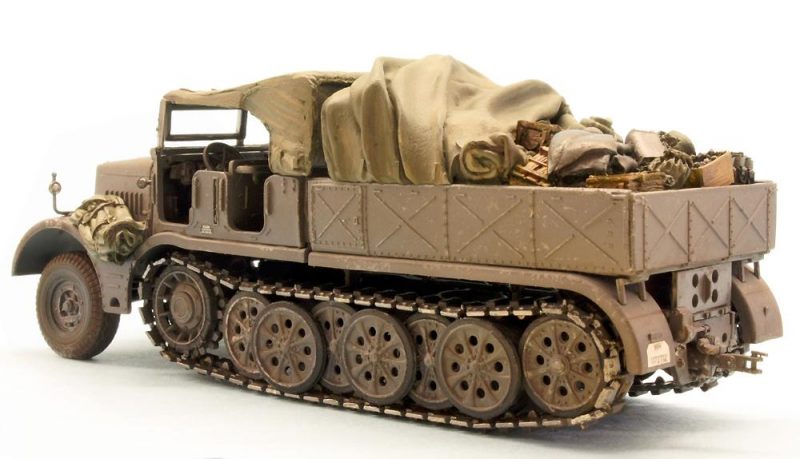
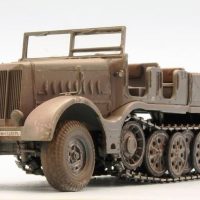
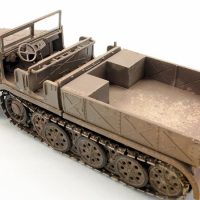
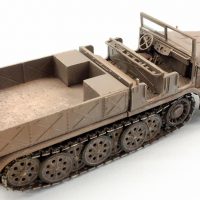
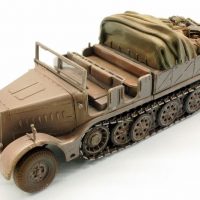
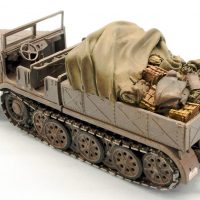
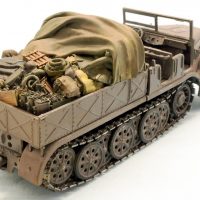
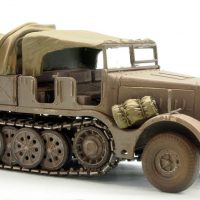
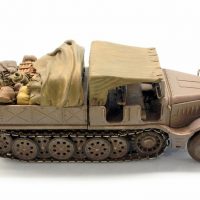
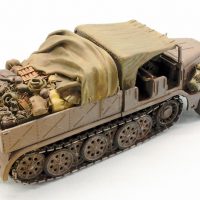
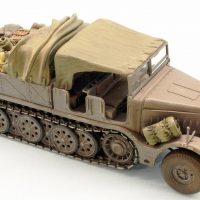
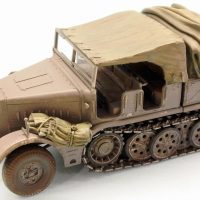

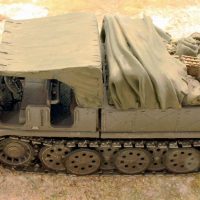
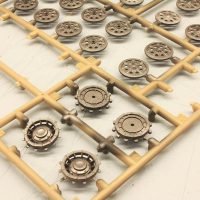
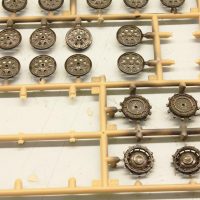

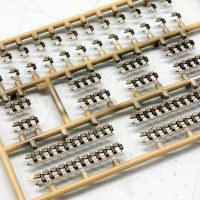
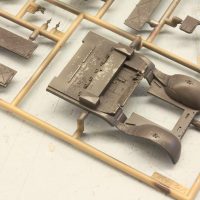
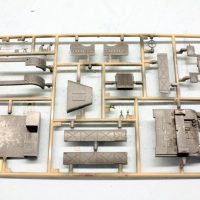
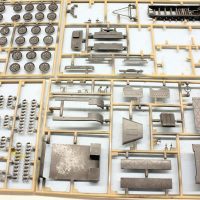
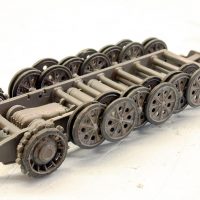
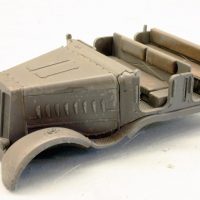
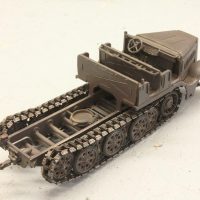
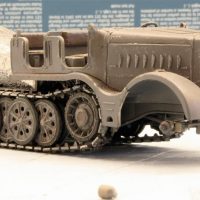
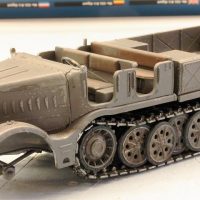
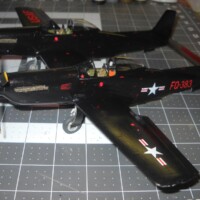
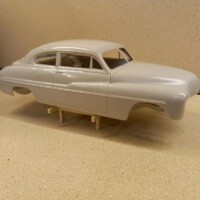
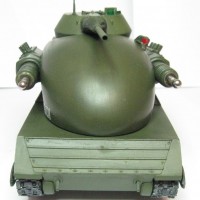
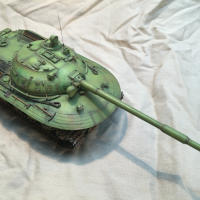
Great article and model Roland. Thank you for the tips on The painting procedure. It looks really good. Can wait to see your “Gigant “ being towed by this machine !
Thank you for your comment, I will be happy to show the "Gigant" here soon!
The only reason I am aware of this vehicle (passenger sans cargo deck) is because of the movie "The Dirty Dozen" where one becomes the surviving Dozen's escape vehicle.
This model definitely feels the part with the weathering and paint job.
Splendid! I haven't seen the film for too long, but your comment will be cause for me!
Great build, I completed this one 10y ago, very detailed kit for its size in 1/72!
Thank you very much!
You did your usual miracle on this, Roland!
Amazing detail for the scale, excellent article!
Looking forward to the Gigant, too!
“….usual miracle…”:Those are very kind words, thank you for that Spiros :))
Very nice indeed, a great build.
Great build, Roland, especially in this scale, really looking forward to the future posting with the Gigant, definitely liked.
Thank you both, Robert and George! Today I managed to post die "Gigant"